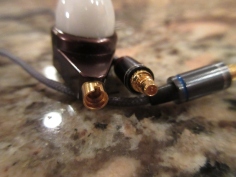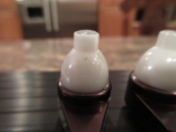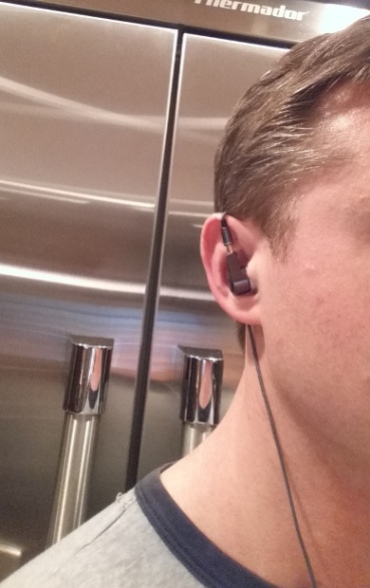Like a pure water.
PROS: a very coherent tuning of Dynamic and Planar Magnetic drivers, super transparent layered sound, semi-open design with 3D staging, many designs to choose from.
CONS: proprietary cable connector, fit might not be for everyone.
The product was provided to me free of charge for the review purpose in exchange for my honest opinion.
Manufacturer website: oBravo, for sale on Moon-Audio and Audio-Sanctuary.
Intro.
What do you recommend to an audiophile who has everything from multi-BA and wide bandwidth DD monitors to hybrids with the best of both worlds? How about the first ever coaxial 2-way hybrid in-ear monitor that combines Dynamic (DD) and Planar Magnetic (PMD) drivers! PMD headphones are constantly in the news, especially with recent announcements of scaled down IEM implementations, but many don’t realize that oBravo was an early adaptor of this technology when 2 years ago they introduced the first IEM featuring PMD tweeter. Established over a decade ago, oBravo Audio dedicated a lot of their time and resources in the R&D, focusing on technological advances of audio speakers, including patented Air-Motion Transformer (AMT) “ribbon” technology. The result of this hard work could be seen today in ERIB series (hybrid design of DD + PMD) and EAMT series (hybrid design of DD + AMT), both of which are the highlights of their product line.
Quite often my readers ask for recommendation of a new IEM that won’t overlap with their existing collection. It’s not always an easy task especially when requests come from those who keep up with every flagship flavor of the month. So, when I was presented with an opportunity to test and to review oBravo flagship ERIB1C model, I was curious to try something new with a totally different driver configuration which includes PMD. I have a few full size planar magnetic headphones, and they fall into either a warmer or a brighter sound category, and I wasn’t sure which path ERIB1C is going to follow. While reading about oBravo, I also found it interesting to see so many different models and variations within each their offer. As an example, they have ERIB 1 through 8, all featuring the same 8mm PMD tweeter and different size DDs where FR upper limit stays at 35kHz while low end extension changes from 15Hz (12mm driver) to 32Hz (6mm driver). Furthermore, they also offer 3 choices of earcup (front of the shell chamber) materials, denoted with a suffix C (precision ceramic), W (wood), and A (aluminum) which affect the low-end characteristics. EAMT has a similar variation with EAMT 1 through 5, except AMT tweeter tech extends FR to 45kHz.
It felt like you’re dealing with a Custom universal IEM where you first choose a tweeter technology (PDM or AMT), then dynamic driver size (from 12mm to 6mm in ERIB or 12mm to 9mm in EAMT), and finally decide which earcup material gonna suite your bass needs better (C – neutral, W – warm, A – punchy). These choices will not only shape the final sound, but also will affect the price, where AMT, ceramic, and larger DD will drive it up. Considering I had an opportunity to test ERIB1C, that’s the only combination I will be able to describe in my review. For other combinations to match your personal taste, I would strongly recommend contacting either oBravo or their official distributors to help you choose the “custom” combo. Since they share the same tweeter, I have a feeling the most noticeable sound variation will be in a selection of earcup material with Ceramic and Aluminum being the more popular choices. So, let’s take a closer look at Ceramic version of ERIB1 featuring 12mm DD and 8mm PMD tweeter.
Unboxing.
The product arrived in a very environmentally conscious cardboard box, without any fancy cover art, only featuring a company logo and an outline drawing of two shell designs: larger driver models feature an extended vertical body while smaller driver ones have a traditional cylindrical shape. Opening the top of the box revealed a metal travel case, designed with two lightweight aluminum shell halves zippered together. Top part of the case had a mesh pocket for accessories, while the bottom had a foam block with cutouts for IEMs, cable, and extra accessories.
It’s a unique custom travel case, not your typical Pelican 1010 or generic zippered clam shell, but not exactly pocket friendly. Great to protect ERIB/EAMT when you are traveling, but I wish they would have included additional smaller case just for IEMs. I’m sure it’s not a problem to find one, just keep in mind that you don’t want wooden faceplates or ceramic parts of the shell banging or rubbing against each other, thus a need to keep them separated.
Accessories.
In additional to a printed manual with some useful info about the product, oBravo included a set of S/M/L genuine Comply eartips (blue foam), and another set of S/M/L hybrid silicone eartips. To enhance the fit of the shell in your ears, you will also get a set of S/M/L removable fins, typically found in sports earphones. I will talk more about the fit in the design section of the review, but for me personally eartips selection was very critical to keep ERIB1C secure in my ears.
Also, there was 6.3mm headphone adapter – a rather neat design with a less bulky connector. But the highlight of the included accessories was 6 nail-shaped metal pins. The travel case featured 6 cylindrical cavities occupied by each pin, and no matter how I looked at it, I couldn’t figure out their intention. This is a first time I had to “stop and ask for directions” from oBravo rep because I had no idea what I’m looking at. Turned out these were “skewers” to “shish kabob” eartips for storage. Practical or not, this is a rather original accessory.
The cable.
As many of you know, I enjoy cable rolling while searching for the best synergy of various aftermarket cables with headphones under test. Unfortunately for me, oBravo IEM comes with a proprietary mmcx connector which has an interlocking design. You still have mmcx based connector, but the cable side of it has a little notch while the shell side has an extended collar with a cutout that interlocks with a notch, preventing cable from spinning. There is no denial, mmcx connectors are more prone to issues, in comparison to 2pin, because the cable is not fixed from rotation, the dirt and moisture can get inside causing lose of contact and oxidation, and in general you get more wear’n’tear. oBravo’s modified connector solution addresses most of these issues. But at the same time, many audiophiles already have various 2pin and mmcx replacement cables which they won’t be able to take advantage of. Also, having a standard universal connector means a wider selection of replacements if it breaks.
The provided OFC cable looks basic, with a gold plated straight 3.5mm TRS plug in a slim laser etched aluminum housing and a nice strain relief. Y-splitter has a matching design, no chin-slider which I think not necessary since we are talking about a wire down design. The earpiece connectors also match the headphone plug and y-splitter finish, and have a color-coded Red (right side) and Blue (left side) rings for ID. This is a very important design element because ERIB1C shells are identical and symmetrical, you can switch them between L/R sides and the color rings are the only indicator of which one is which. The cable jacket has a neat tight nylon braiding, making the cable looks nice, but be aware those are usually susceptible to more wear after a while of use. Plus, due to a tight braiding and the selection of the material – there is a noticeable microphonics effect.
Overall, the cable does look nice, thin and pliable, and I’m sure oBravo team tuned their IEMs sound while keeping in mind the contributing audio factor of this OFC cable. I also been told, they offer their customized mmcx connector for building aftermarket cables, so there is still a solution if you want to try fancy silver or pure copper wires. My suggestion for oBravo is to make a short interconnect cable adapter with proprietary mmcx connector on one side and universal (and an alternative 2pin version) on the other side. This way you can use any cable with oBravo IEMs.
Design.
I already provided quite a few hints about the design in previous sections of the review. Both ERIB and EAMT models feature two different shell types. ERIB1 & ERIB2, as well as EAMT1-3, have a vertical “teardrop” shell design, most likely to accommodate larger DD. While the rest of the models with smaller DD drivers have a traditional cylindrical “bullet” shell. All the models feature a wooden vented back “faceplate” with a carved oBravo logo, which is part of their semi-open design, surprisingly with a tolerable sound leakage. When you are right next to IEM, you can hear some sound, but about 6″ away it starts to fade away. I wouldn’t recommend to use these at the library, but they are OK for other public places, even on a bus or a train. Obviously, don’t expect a super isolation either, but it was not bad at all. The design strikes a perfect balance between open-sound performance without super annoying sound leakage or poor isolation. Another vent is located below the nozzle. I already talked about the cable connector, it’s interlocking and the shell side of it features an extended colar with a cutout for a notch. Also, both shells are identical and you can swap L/R, as long as you pay attention to the cable connector with Red (right) and Blue (left) channel ID marker.
The cylindrical shell features a material specific to your design choice: ceramic, wood, or aluminum. Larger vertical shells have an aluminum contour frame and inner shell earcup part with a material of your choice, the same as above. ERIB1C had a white ceramic earcup, 11mm in diameter and 9mm in dome height, which extends into a short 6mm nozzle with 4mm diameter covered by a metal mesh grill. Everybody has a different ear anatomy, so your experience will vary. Plus, depending on eartips selection you can control not only the seal but also how secure the shell will be wedged into your ear. Keep in mind, these are intended for a wire down fit, so you no longer have a security of over the ear wire hook. Instead, you can add a removable silicone fin which usually goes into your concha cymba area of the ear. My earcanal opening is wide and shallow, as a result the shell can’t go too deep which means a short nozzle usually is not my friend, and the fin would be far from my ear. Instead, I had to choose a proper eartip to keep the shells secure in my ear.
I don’t expect everybody to have the same experience since we all got different ears, and between the selection of included eartips (both silicone and foam) and the fins – you can definitely find the one which gives you the best fit and comfort. The shells are very light, I weighted each one to be only 4g (without eartip). So, there is no issue with them weighting down, just need a proper eartip selection. I even tried over ear fit, but it felt awkward, at least with a vertical shell design. Not sure if it will work better with a cylindrical shell, but you can see in the pictures below how it looks with ERIB1C using wire down and wire up.
My only suggestion to oBravo here is to make a little lip at the tip of the nozzle to prevent eartips from sliding off, especially since nozzle is rather short and slippery when using ceramic material [EDIT: oBravo got back to me on this, Aluminum shell has a lip already, but due to a manufacturing process of Ceramic and Wood material and smaller size of the nozzle – this is not feasible]. If there is a way to slim down the cone shape of the inner earcup, that would make the fit more comfortable as well, though I’m not sure if this particular shape was required to fit the drivers and as part of sound tuning. It’s definitely not a showstopper since a proper selection of eartips can take care of all these comfort issues, especially if you are using foam tips – they have the best isolation and the most secure fit.
The fit.
Page 2: Sound analysis, Comparison, Pair up, and Conclusion.



























Great review! Great Pics!
LikeLike
Which one better compare to eamt 1 series
LikeLike
Sorry, I’m only familiar with erib-1c.
LikeLike
Disappointed with the eartips provided. None were suitable for my ears, so I hope Comply provide a wider range themselves. The volume was far lower than my Shure SE846s, which kinda shocked me. Maybe with suitable buds, I’ll get louder sound?
LikeLike
Yeah, you need to try different tips, and comply works good, both to hold iem securely in your ear and also to offer more bass 😉 I’m still going through different tips, and for my ears found ue900 tips to work quite well, but it’s obviously very subjective…
LikeLiked by 1 person
The 846’s are extremely sensitive at 8ohms, which explains that most other pair of iems will require much more steps on the volume knob to volume match the 846.
The Obravo IMHO, shall never be sensitive, in despite of being iems these are not meant for OTG usage. These are quite similar in usage to the Shure KSE1500 and Audeze LCDi4. You can’t rely on them to be extremely portable or environment proof in terms of noise cancellation (exception to the KSE which isolates well but with a rather bulky package), nor they sound perfectly good out of a mere dap or smartphone without amping.
This is not your regular pair of iems purchase, nor an upgrade or a downgrade over what you already have in stock. These are unique in their own way, some sort of “off-road” monsters that requires the right setup to release their full potential.
I have the EAMT 3A and I can’t really compare this set to my Shure 846 and Noble K10UA, I will have to use the word “different” in every way as they sound closer to a premium pair of full size speakers rather than a pair of iems. So sad they don’t receive that much love from the audiophile community and that they cost an arm and a leg.
LikeLike
Now available by oBravo audio España
LikeLike